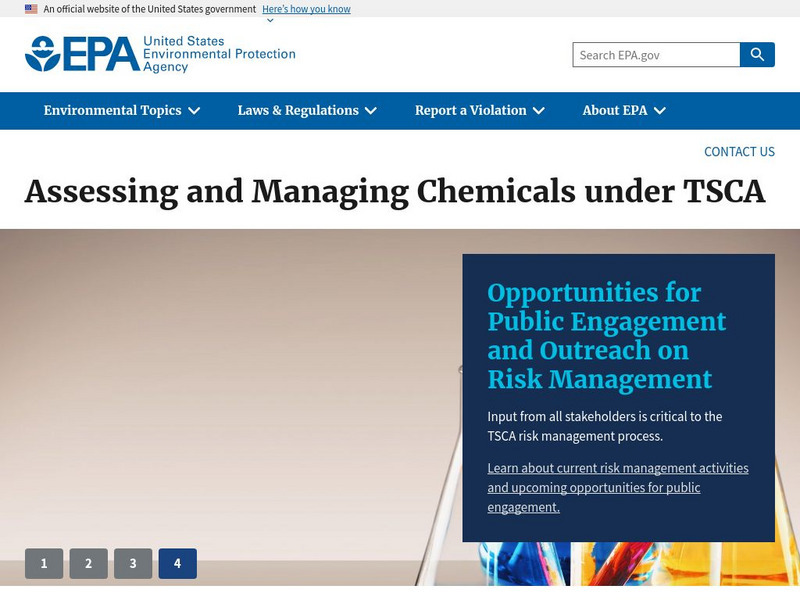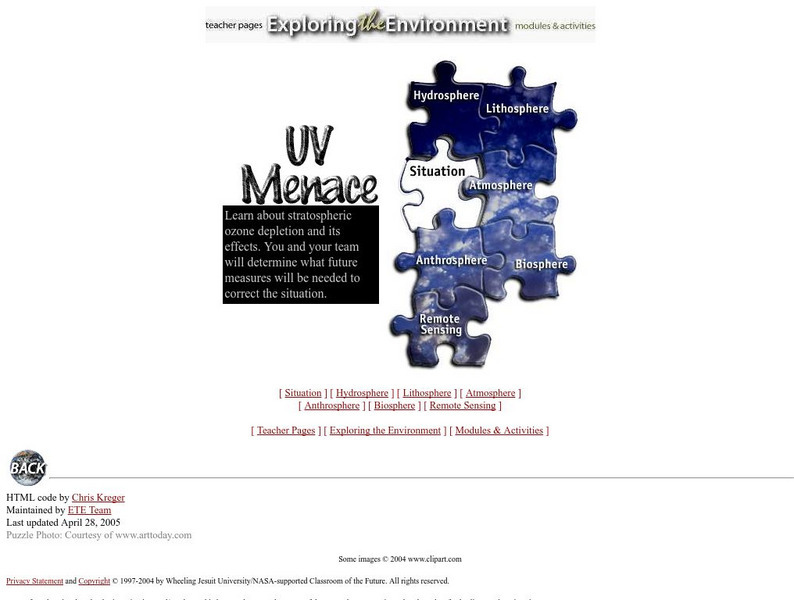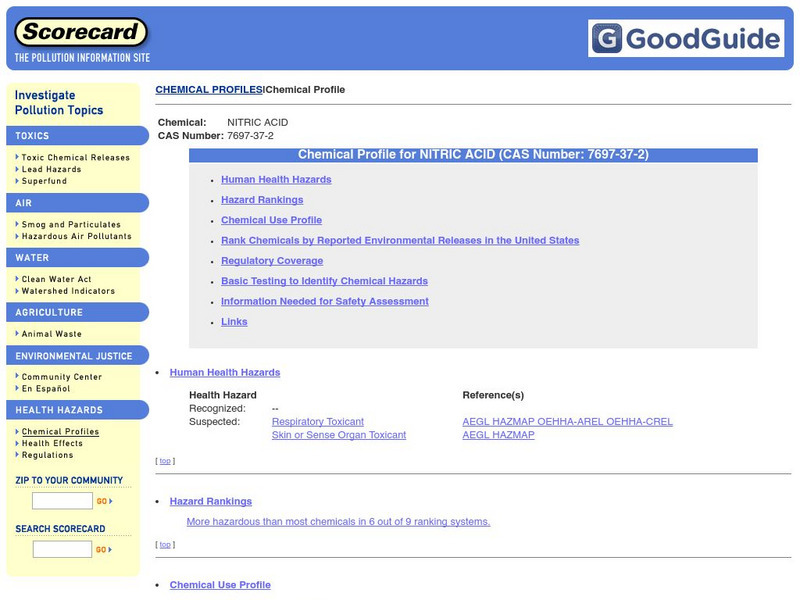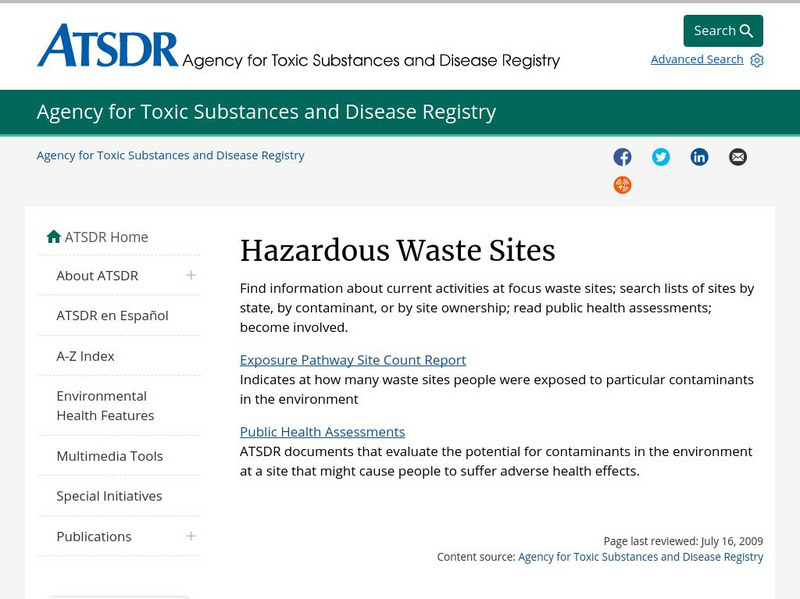National Institutes of Health
Nih Curriculum Supplement Series: Chemicals, the Environment, and You
This comprehensive site from the Office of Science Policy offers a teacher's guide, lesson plans, and student activities that discuss the presence of chemicals in the environment and how they might affect one's body.
Other
Rensselaer Polytechnic Institute: Chemical Equilibrium
This site from the Rensselaer Polytechnic Institute provides an introduction to chemical equilibrium, covering equilibrium expressions, the pH scale, and presenting how to plot log concentration diagrams.
Other
Pollution Probe: Mercury in the Environment [Pdf]
High levels of mercury exposure can cause birth defects, permanent brain or kidney damage, and/or death. This resource focuses on the impacts of mercury in the environment. Learn how mercury can reap havoc on lakes and other aquatic...
Biotechnology Institute
Biotechnology Institute: Your World: Health Care, Agriculture, Environment [Pdf]
Take a closer look at some of the ways in which biotechnology is applied to help solve medical issues and improve our environment.
Massachusetts Institute of Technology
Mit: Open Course Ware: Chemicals in the Environment: Toxicology and Public Health
A college course featuring instructor's notes and case studies about the relationship between exposure to environmental chemicals and human diseases.
US Environmental Protection Agency
Epa: Learn the Issues: Chemicals & Toxics
This site provides real-world issues as well as the scientific research and technology used to support the EPA's mission to protect human health and safeguard the natural environment.
Rice University
Rice University: Web Adventures: Uncommon Scents
An online game looking at household items contain toxic chemicals and evaluate how they affect our health.
Other
Wet in the City: A Recipe for Clean Water [Pdf]
In this hands-on lesson, students will examine the labels on common household products to determine what hazardess chemicals they contain, then test less toxic alternatives to see their affects on water quality. Students will also gain...
National Institutes of Health
National Library of Medicine: Tox Town: Environmental Health Concerns
Learn about toxic chemicals and the environmental healths risks you might encounter everyday in familiar places. Select neighborhoods or locations to discover what chemicals might be found there and the health risks associated with each.
US Environmental Protection Agency
Epa: Chemicals in the Environment
Information summaries on some chemicals and descriptions of how you might be exposed to these chemicals, how that exposure might affect the environment, etc. Please note that this type of information changes rapidly.
Center for Educational Technologies
Nasa Classroom of the Future: Environment Module: Uv Menace
This site provides information and activities for classes to learn more about ozone depletion and UV radiation.
PBS
Pbs Teachers:hazardous Chemicals in Your Neighborhood
Identify hazardous chemicals and their effect on human health and the environment. Explain the importance of cleaning up hazardous waste, and identify facilities and agencies that deal with hazardous chemicals.
National Institutes of Health
Niehs: Kids' Pages: What's Wrong Whiskers?
Online children's story that teaches about the health effects of exposure to environmental hazards such as chemicals. Click on "next" at the bottom of the story to see why Whiskers, the family cat, becomes ill from all the chemicals used...
University of Alberta
The University of Alberta: Nmr Spectroscopy
1HNMR theory begins in the nucleus of hydrogen. Complete this tutorial on the 1HNMR spectrum graph to learn about the number of equivalent hydrogens, b) the chemical environment of each hydrogen type and c) the number of neighbouring...
NOAA
Noaa: Office of Response and Restoration
Here are tools and information for emergency responders and planners, and others working to understand,.the effects of oil and hazardous materials in our waters and along our coasts. Links to oil/chemical spill information and photos....
Centers for Disease Control and Prevention
Centers for Disease Control: Antimony: Atsdr Fact Sheet
This resource describes the chemical element antimony (chemical symbol Sb) and gives detailed information about its effects on human health and the environment.
University of Toronto (Canada)
University of Toronto: Hazardous Materials Information
This page provides links to safety data sheets on hazardous chemicals and micro-organisms that might be used in a laboratory or workplace environment.
Other
Digital Library for Earth System Education (Dlese)
This resource provides materials for teachers on a huge array of topics. Search site by topic, grade level, and desired output (such as lesson plan, case study, assessment or tutorial). Site is focused on earth science, geography, and...
TeachEngineering
Teach Engineering: Grow Your Own Algae!
Students discover how tiny microscopic plants can remove nutrients from polluted water. They also learn how to engineer a system to remove pollutants faster and faster by changing the environment for the algae.
Science Education Resource Center at Carleton College
Serc: Investigate Effects of an Oil Spill
This lab is designed so that students will understand the effects of oil spills on plants, animals, and the environment and investigate clean up methods through a simulated oil spill. They will understand the risks associated with...
National Institutes of Health
Niehs: Kids' Pages: You and Your Genes
Online children's story that teaches about genes and how they direct how you react to things in your environment. Click on "next" at the bottom of the story to see how different people respond differently to harmful substances.
National Institutes of Health
Niehs: Kids Pages: Crabby Kathy
Online children's story that teaches about the health effects of exposure to environmental hazards. Click on "next" at the bottom of the story to see why Kathy becomes "crabby" from all the chemicals and contaminants in her room.
Other
Environmental Defense Scorecard: Nitric Acid
This resource provides a complete chemical background on nitric acid including health hazards, environmental hazards, regulatory information, and safety.
Centers for Disease Control and Prevention
Centers for Disease Control: Atsdr: Superfund Hazardous Waste Sites
Extremely detailed look at the dangers associated with the hazardous and solid waste sites in the U.S.
















